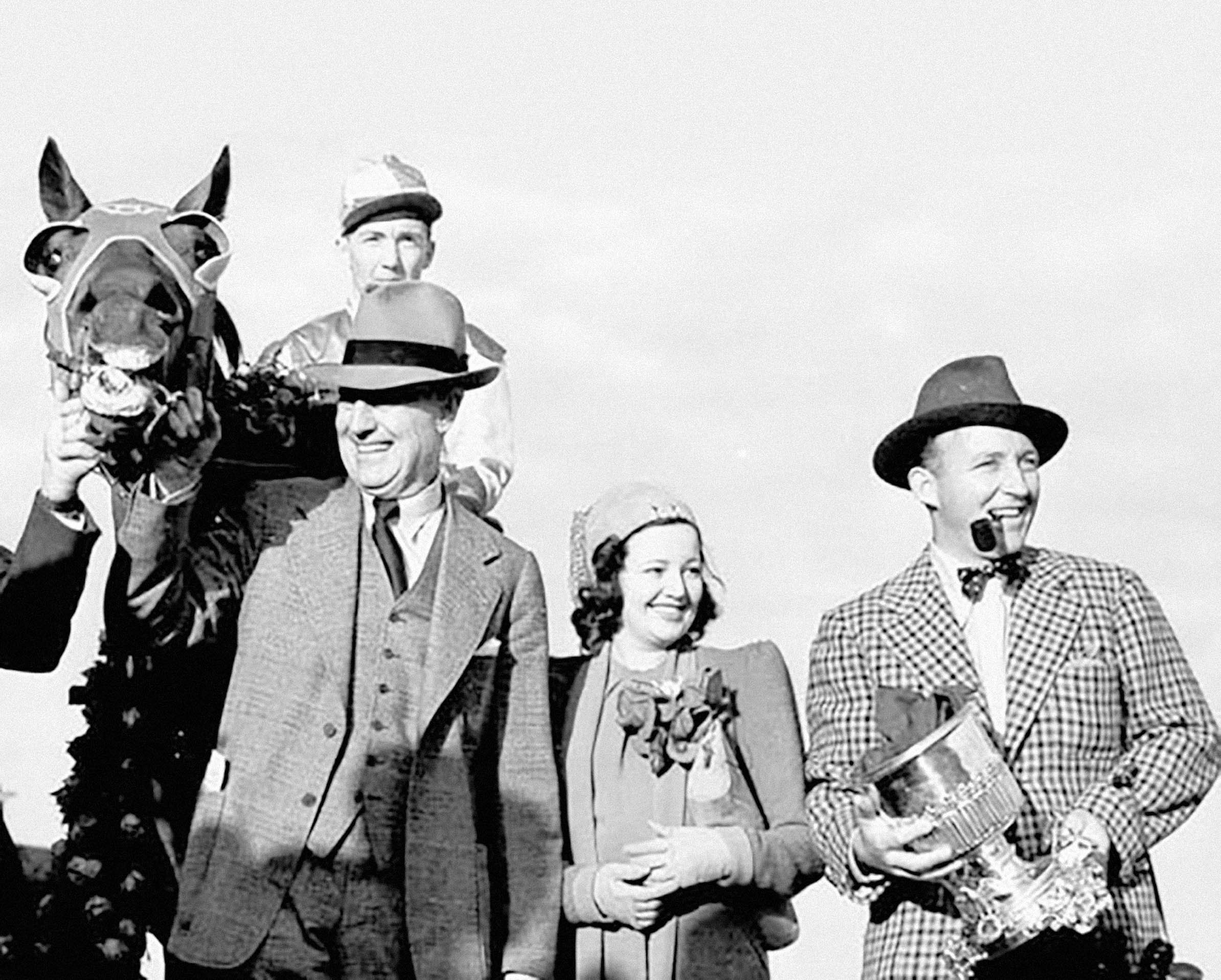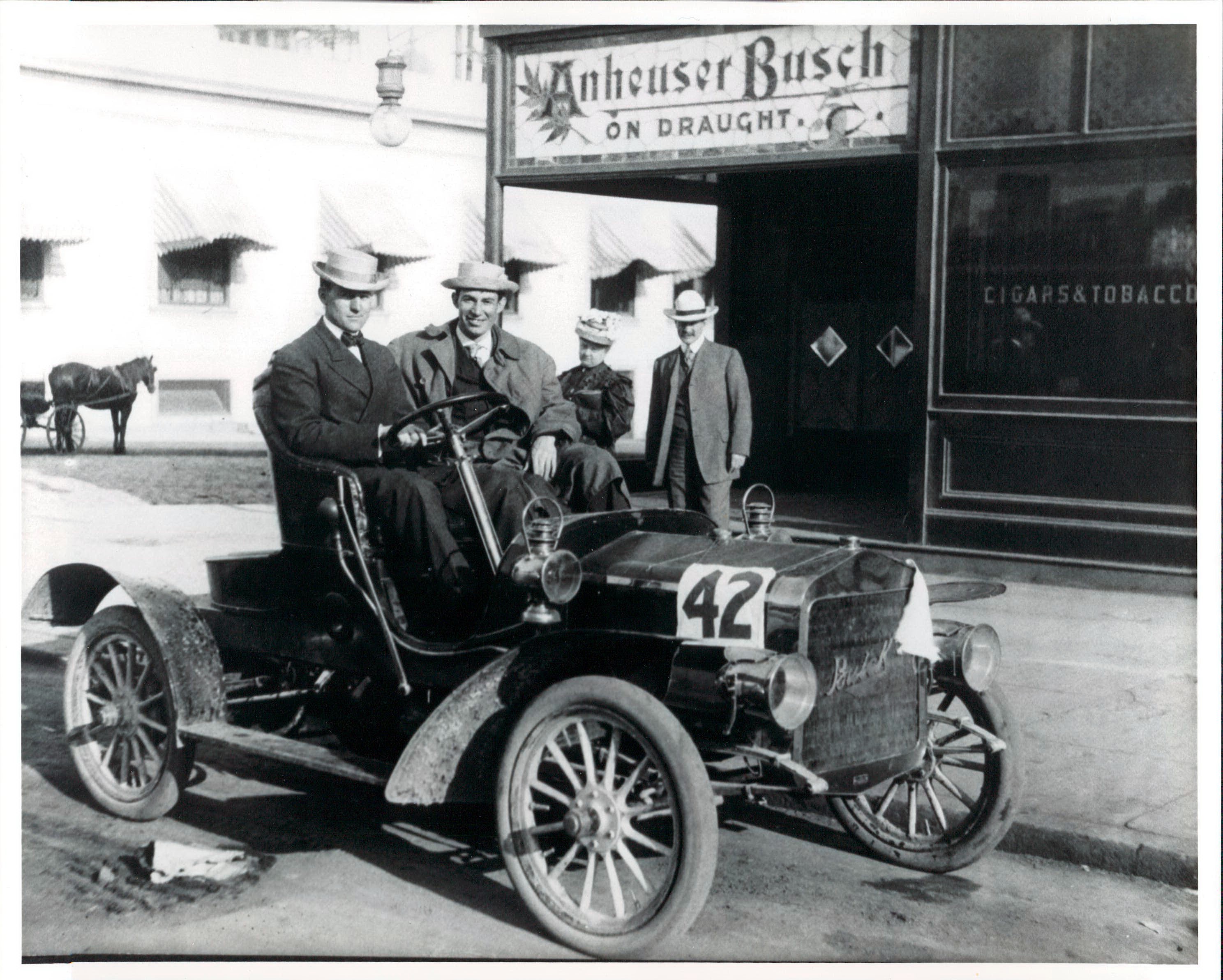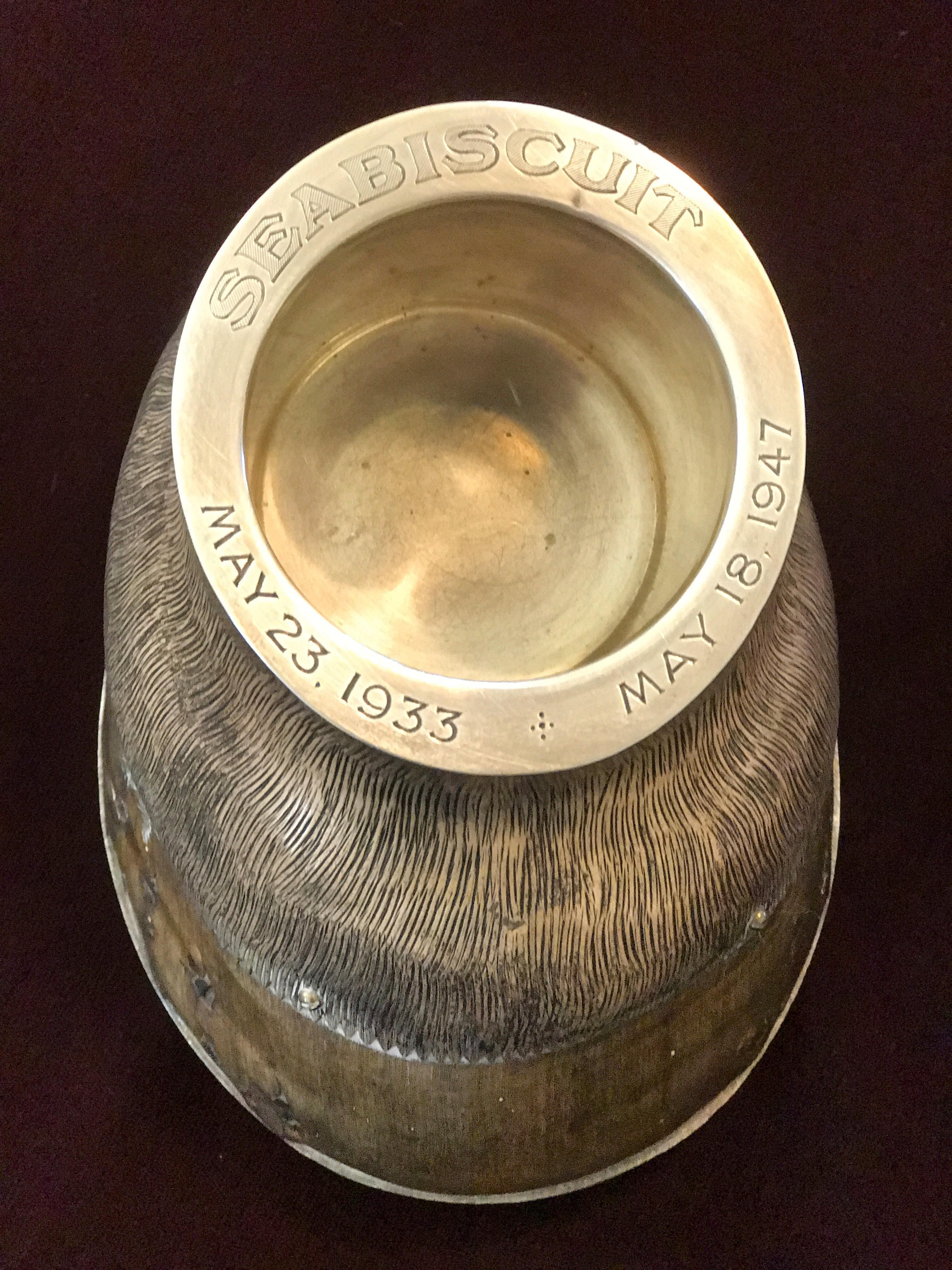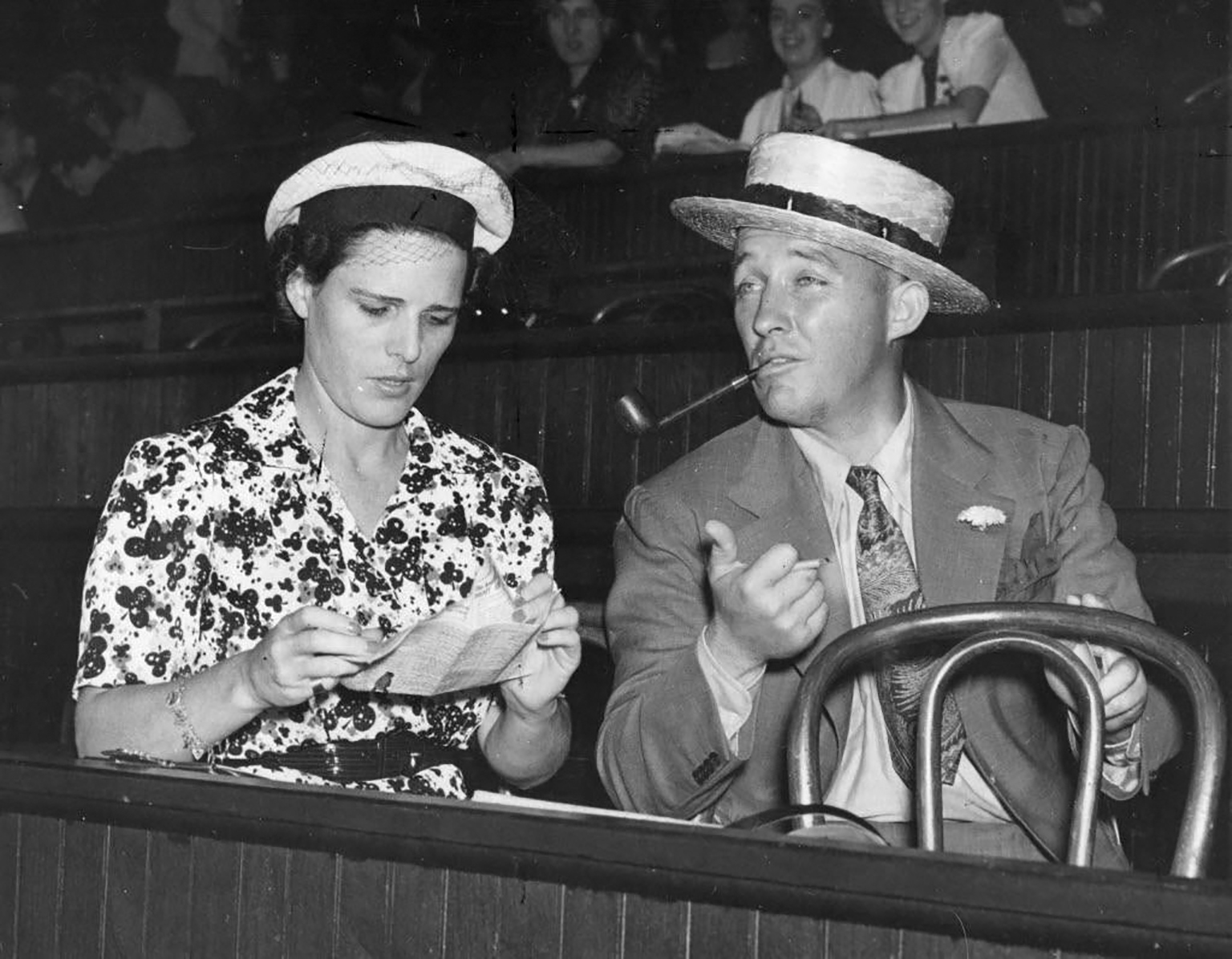
There was a time when the greatest tribute owners could pay to their favourite racehorses was to preserve their hooves - and sometimes other parts of their anatomy - as cherished mementoes, often displayed around their homes. Carly Silver reports.
One chilly afternoon in November 2018, I entered a basement storage room at the Keeneland Library in Lexington, Kentucky. Out of the corner of my eye, I spotted a gleam of silver. Gently lifting a pile of stacked papers, I found buried treasure beneath: two hooves, outer walls plated in thick silver.
Each bore a delicate inscription. One bore the name ‘Pharis’, all in capital letters, with two date ranges: 1936-40 and 1945-57. The second hoof read ‘Tourbillon’, inscribed in smaller capitals, with 1928-1954 below.
Both names echoed within my memory; these horses were homebreds for French horseman Marcel Boussac, whose Haras Fresnay-le-Buffard was a dominant force in Europe in the middle of the 20th century European racing. I immediately remembered the recent news item about hooves: the grand Seabiscuit’s preserved hooves had been tested for DNA … Could these hooves, dating from the same period, represent the same tradition?
As animal historian Dr Susan Nance has noted, the best racehorses were portrayed as ‘game’ creatures who transcended animalhood and almost achieved humanity. They embodied the qualities attributed to some humans. They were deemed wise, competitive, fierce, noble, persevering in the face of pain and adversity. Winning horses were thus revered as heroes, cast in the mold of triumphant humans, and so too were they memorialized.
If they revered their horses, why would owners dismember them and turn their hooves into household ornaments?
Burying racehorses’ massive bodies has always been labor-intensive and expensive. As a result, owners often inter just their heads, hearts, and hooves, and discard the rest of the body. As Colonel Mike Howard, great-grandson of Seabiscuit’s owner, Charles S Howard, told me, “The head is the thinking part of the horse, the heart is what drives the horse and ... the hooves represent the speed of the horse …”
For Boussac, Pharis epitomized excellence on the track and at stud. A son of the Earl of Derby’s blue-blooded Pharos, Pharis (also known as Pharis II) won all three of his races, highlighted by the 1939 Prix du Jockey Club and the Grand Prix de Paris. After that last-named race, he was set to ship to take on brilliant British counterpart Blue Peter in the St Leger, but that failed to materialize during the onset of World War II. He retired to Fresnay-le-Buffard in 1940, standing at that nursery until the Germans commandeered him.
After the war, Pharis was returned to Fresnay-le-Buffard, where he lived from 1945 until his 1957 death.
Returning to the preserved hoof in the Keeneland Library, then, one can surmise that Boussac chose to memorialize the two periods in which he directly owned Pharis. Boussac’s proprietary nature rings true; he reportedly refused to issue stallion service certificates to Pharis’s progeny conceived while in Germany, meaning those offspring couldn’t be registered as Thoroughbreds for years.
Besides Pharis, Tourbillon was arguably the greatest product of Boussac’s breeding and racing operation.
A son of Ksar, Tourbillon was out of Grand Critérium winner Durban, whom Boussac purchased as a youngster. A foal of 1928, Tourbillon captured the 1931 Prix du Jockey Club, among other top-flight stakes. He eventually led France’s sire list three times and became a cornerstone of Boussac’s breeding empire.

As homebreds who achieved great feats on the track and in the stud, reaping rewards for their owner-breeder for generations to come, Pharis and Tourbillon exemplified Boussac’s focus on equine excellence … the ideal homebreds to memorialize.
The tradition of preserving hooves and turning them into trophies, literal or figurative, extends to one of the most famous horses ever, Eclipse, after whom America’s year-end Thoroughbred championships are named. His hooves were preserved.
Eclipse and his owner, charismatic con man Dennis O’Kelly, earned renown in the industry and public consciousness alike. After Eclipse’s 1789 death, all four of his hooves were removed, cleaned, and treated by a taxidermist, but the existence of as many as nine hooves ‘belonging’ to Eclipse was reported, according to the horse’s biographer, Nicholas Clee.
The impossible number of these hooves is eerily reminiscent of the proliferation of saints’ relics (multiple heads, a seemingly infinite amount of fingers). In the process, the legends surrounding Eclipse’s hooves have elevated him to a nearly divine figure. And equine royalty was gifted to human royalty, as equine historian Dr Esther Harper noted in her graduate thesis. William IV of the United Kingdom presented a mounted hoof to the Jockey Club in 1832; after, the hoof was used three times as a trophy in the Eclipse Stakes before being stored away.
A century later, this habit continued. The most famous taxidermic artist of the Victorian era was Rowland Ward. In his 1885 pamphlet Observations on the Preservation of Hoofs and the Designing of Hoof-Trophies, Ward advertised his services. He described his ability to preserve as “mementoes of the hunt” or “memorials of favourite animals that have been possessed and prized”, turning animals’ limbs into lamp-stands or other household items.
He emphasized the necessity of preserving the hoof’s ‘natural’ image; that would allow the trophy’s owner to preserve a specific memory associated with that animal’s body. This same tradition was popular with warhorses in America. Around the same time, some American military figures taxidermied their valiant mounts, like Union Army Captain Myles Keogh’s Comanche and Confederate General Stonewall Jackson’s Little Sorrel.
More recently, the underdog champion Seabiscuit’s preserved hooves made the headlines.
Physiologist Dr Steven Tammariello at State University of New York-Binghamton tested their DNA to discover what genotypically made Seabiscuit so extraordinary. And it’s thanks to Seabiscuit’s owner, Charles Howard, that Dr Tammariello had these hooves; Howard chose to memorialize Seabiscuit’s greatness by keeping his great champion’s hooves in his own home.
Like O’Kelly and Eclipse, neither Howard nor Seabiscuit were defined by their bloodlines, but by their career successes. Howard, an American racecar-driving daredevil-turned-motor magnate, and Seabiscuit, whose pedigree carried whiffs of greatness but was a few generations removed from equine immortality, were upstarts.
The media latched on to the narrative of handsome Howard emerging a success from the ashes of tragedy after his young son died in a horrific car crash. As Laura Hillenbrand recounted in her eponymous biography of Seabiscuit, Howard forever after kept a memento mori, a portrait of young Howard, in his San Francisco office, and would ask guests of the image, “Do you think it looks like me?”

Seabiscuit, who began life in the famed Phipps stables but dropped to the claiming ranks before rising to great heights, became Howard’s equine counterpart; both man and horse gamely persevered to achieve greatness in the face of personal pain and hardship. Seabiscuit’s success on the track in the 1930s and 40s corresponded with Howard’s own renewed happiness. In 1932, he wed Marcela Zabala; he knew the vibrant young actress because her sister, Anita, was married to one of Howard’s sons from his first marriage. The Howards and their star racehorse received glowing media portrayals.
After Seabiscuit’s 1941 retirement, Howard turned his Ridgewood Ranch into a pilgrimage site, complete with a grandstand for tourists; in the first seven months of that year, over 33,000 people visited the ranch to see ‘The Biscuit’. But Seabiscuit died young, due to a heart attack, striking his owner with another monumental loss; though Howard owned more champions, none ever meant as much as The Biscuit, whose heart and courage matched his own.
How could he properly pay homage to the horse who meant the world to him? By preserving him for all time, of course.
Besides Boussac, other contemporary owners engaged in this practice. When the immortal Australian racehorse Phar Lap died in 1932, owner David Davis ordered the grand chestnut’s hide to be mounted; it is still on display in the Melbourne Museum. Over in Hollywood, a few decades after Seabiscuit’s death, Roy Rogers had the skin of his ‘wonder horse’ Trigger mounted over a plastic frame of a rearing horse.

Howard wasn’t always keen on the idea, revealed Colonel Howard. He noted, “So when Seabiscuit died, the foreman of the ranch - when my great-grandfather was making the decision on where to have him buried - said, ‘Should I take his hooves off?’ And initially my great-grandfather said no. He just didn’t want to have the horse touched. And then later, the ranch manager came back to him again and insisted on doing it.
“He said, ‘You know, someday you’re going to wish you had done that. Everyone else does it with their most famous horses.’” Howard Sr obliged, burying the rest of Seabiscuit at a ‘secret location’ on Ridgewood Ranch.
Seabiscuit’s hooves were given new life, turned into trophies and displayed around the Howard home. Like the portrait of his son Frankie, these hooves allowed him to freeze those precious memories in time. By asking questions and interacting with the hooves, guests to the ranch would become more than people looking at objects, but spectators rearticulating the past in the present. By retelling stories of Seabiscuit’s triumphs, then, Howard became the architect of Seabiscuit’s continued memory.
But these hooves didn’t just sit around doing nothing … Just as Victorian hooves were turned into inkwells or lamp-stands, Howard’s were used as cigarette holders. “If you had a big party or something, there’d be fresh cigarettes in each one of these,” Colonel Howard recalled.
To those of us raised with anti-smoking ads, putting cigarettes inside a relic of a beloved animal seems odd, almost a profaning of sacred items. But these were different times.

Howard continued, “You’ve got to go back to the 1920s and 30s and 40s, where smoking was something that the elites did … Remember Lucille Ball and people would do these advertisements: ‘Life's better with a Chesterfield.’ Well I remember them. They would have a horseshoe and then there was a shallow area where you could lay your cigarette. Like you would put hors d’oeuvres for the party, like you’d put out something really nice — plates and whatever. The cigarettes were all fresh. They didn’t have filter tips back then; they would take them out of the packet they got them in and they would put them in this hoof so that the cigarette, you could just reach down and pull the cigarette out from the side, and it was an honored thing. There was no denigration intended at all. But it bothered me; it bothered me when I was a little kid.” At that time, if you were anyone, you would smoke.
So a good host would offer up cigarettes, and what better way to bring up your champion racehorse, a status symbol in and of itself, by offering up cigarettes in a piece of that horse?
Colonel Howard added, “Parties were just filled with people smoking and here you had these hooves beautifully displayed on the tables or whatever, scattered throughout where the crowd was, and people would get their cigarettes right from [them], provided free by the host. You would reach over to these hooves to pull out a cigarette just like you would get a drink, a martini or something.”
Much like devotees took home pieces of saints’ relics, visitors to the Howard home also nabbed pieces of the legendary Seabiscuit … including the aforementioned two hooves.
After Marcela Howard’s death in 1987, the Howards donated what remained of their trophies — including the pair of Seabiscuit’s hooves still in their possession — to the California Thoroughbred Foundation and California Thoroughbred Breeders Association. This came at the request of Marcela Howard herself; Mike Howard related that she wanted her family’s legacy to live on by donating “all of those memorabilia, things that were related to horse racing” to the organization.
It’s fitting that California, site of Seabiscuit’s greatest triumphs, became his hooves’ permanent home.
This article was first published in Gallop magazine.
Sources
https://theconversation.com/can-seabiscuits-dna-explain-his-elite-racing-ability-104099?xid=PS_smithsonian
Theconversaton.com: Can Seabiscuit’s DNA explain his unique racing ability?
Toby, Milton C. Noor: A Champion Thoroughbred’s Unlikely Journey from California to Kentucky. History Press, 2012.
Tyrrell, Brian. Bred for the Race: Thoroughbred Breeding and Racial Science, 1900-1940. Historical Studies in the Natural Sciences 45, no. 4 (2015): 549-576.
Wengert, Allen. Seabiscuit’s Secret. Big U News, Binghamton University, 17 April 2019,
Ward, Rowland. Observations on the Preservation of Hoofs and the Designing of Hoof-Trophies. London, 1885.
Willett, Peter. Makers of the Modern Thoroughbred. The University Press of Kentucky, 1986.


